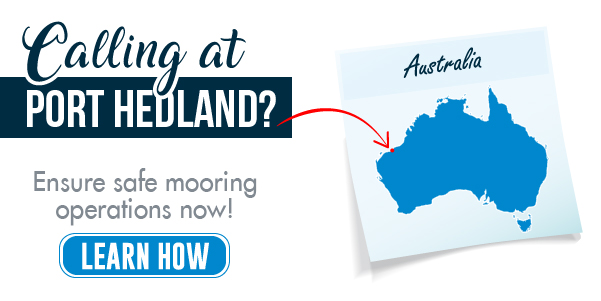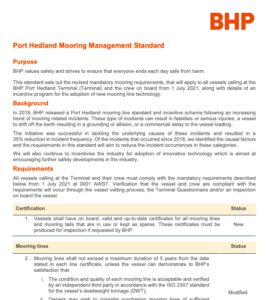Mooring line failures / parted mooring line incidents pose a significant risk to personnel, infrastructure, and operations in the port. Over the past few years, a significant number of mooring line incidents were reported in the Port of Hedland. These form approximately 20% of all marine incidents in the Port
In that regard, BHP issued new updates for the Port Hedland Mooring Management Standard which sets out the revised mandatory mooring requirements, that will apply to all vessels calling at the BHP Port Hedland Terminal (Terminal) and the crew on board from 1 July 2021, along with details of an incentive program for the adoption of new mooring line technology.
a. Parting of a mooring line occurs when it is placed under extreme loads due to environmental factors (large tidal range, strong winds, etc.), passing vessel interactions, loading conditions (ballast vs fully laden, vessel’s trim), insufficient monitoring and tending of mooring lines.
b. In certain instances, mooring lines have parted at loads well below their rated minimum breaking load (MBL) and in the absence of any vessel interaction. Contributing factors to the early failure of lines can be the age, material, quality and condition of the line, conditions that it has been exposed to during use (abrasion, chafing, sharp angles, shock loads), ambient and deck structure temperatures, as well as, at- sea storage conditions.
In 2018, BHP released a Port Hedland mooring line standard and incentive scheme following an increasing trend of mooring related incidents. These type of incidents can result in fatalities or serious injuries, a vessel to drift off the berth resulting in a grounding or allision, or a commercial delay to the vessel loading. The initiative was successful in tackling the underlying causes of these incidents and resulted in a 35% reduction in incident frequency.
Of the incidents that occurred since 2018, BHP identified the causal factors and the requirements in this standard will aim to reduce the incident occurrences in these categories. BHP will also continue to incentivise the industry for adoption of innovative technology which is aimed at encouraging further safety developments in the industry.
All vessels calling at the Port Hedland Terminal and their crew must comply with the mandatory requirements described here from 1 July 2021 at 0001 AWST. Note that the 2018 Terminal mooring line incentive scheme will be superseded by the above incentive scheme on 1 April 2021 at 0001 AWST. The new mooring line technology incentive will be valid for all vessels calling the Terminal meeting this option from 1 April 2021 until 30 June 2022 at 2359 AWST.
Verification that the vessel and crew are compliant with the requirements will occur through the vessel vetting process, the Terminal Questionnaire and/or an inspection on board the vessel.
New mooring line technology incentive
BHP will discount the line handling fee for certain new technology adoption, to incentivise the advancement of mooring line safety improvements. The incentive will apply to the use of products incorporating technology aimed at reducing the snap backs of mooring lines together with the appropriate line management plan, as determined or approved by BHP.
The Wilhelmsen Timm Master 12 Snap Back Arrestor F100 (73mm) 220m and the Wilhelmsen Line Management Plan technology is currently approved by BHP. Alternative mooring line technology options will be reviewed by BHP.
If a vessel berthing at the Terminal has all mooring lines installed of the Wilhelmsen Timm Master 12 Snap Back Arrestor F100 (73mm) 220m type and their use and condition is continually monitored through the Wilhelmsen Line Management Plan, the vessel will benefit from:
- Reduced line handling charges from AU$1600 to AU$600 per Terminal call.
- Mooring lines turned/rotated end to end at a minimum 2500 hours of active service.
- A review of the line condition completed at 4500 hours of active service, or 5 years from certificate date to determine suitability for ongoing use. The line condition will be endorsed by the mooring line manufacturer and approved by BHP.
NB: All lines of the Wilhelmsen Timm Master 12 Snap Back Arrestor F100 (73mm) 220m type, must be retired at age of 5000 hours of active service. Hours of active service is the time the lines are used in mooring operations as logged in the Wilhelmsen Line Management Plan.
The 2018 Terminal mooring line incentive scheme will be superseded by the above incentive scheme on 1 April 2021 at 0001 AWST. The new mooring line technology incentive will be valid for all vessels calling the Terminal meeting this option from 1 April 2021 until 30 June 2022 at 2359 AWST.
In a circular posted by the Pilbara Ports Authority, it is recommended a Mooring Safety Management Plan (MSMP) or similar to be implemented by ship operators to ensure that all assessed risks are effectively managed through the design and operation of the mooring system and that the procedures comply with Port Hedland Mooring Line management. The aim is to ensure that during mooring operations, no harm comes to the ship’s crew or terminal staff, no damage is caused to the ship or terminal/facility it is interfacing with and that the mooring system meets all applicable regulations, codes and recommended practices.
Explore more recommendations by reading the circular by the Pilbara Ports Authority herebelow
View BHP Circular herebelow



































































